 |
What People Are Asking
Questions on Fashion in Ladies' Dress
Marian T. Horvat
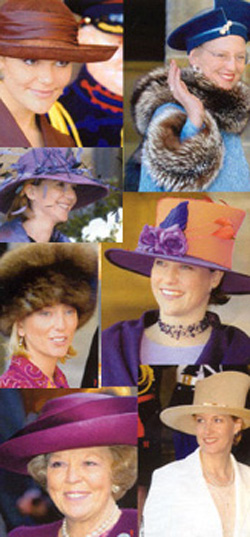
Ladies wearing new hats - clockwise top left, , Princess Victoria of Sweden, Queen Margaret of Denmark, Princess Martha Louise of Norway, Sophie Countess of Wessex, Queen Beatrice of Holland, Princess Marie-Chantal of Greece, & Infanta Christina of Spain
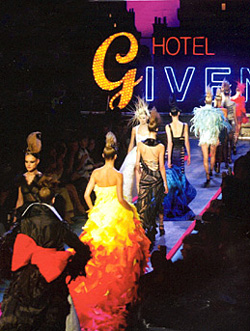
A new season - a new line of clothing, as fashion dictators impose their extravagant and often immoral "creations" |
1. Question – What do you think about the constant changes of fashions in dress?
Answer – There is something right and something wrong about this. The right side is that we as human beings, and especially we women, like to have a certain variety in clothing. It makes life more pleasant and bearable. This is normal. Perhaps it is to fill this psychological need that God changes the “dress” of nature four times a year, in each season. The Catholic Church also changes her ceremonies, vestments and colors several times during the liturgical year.
The wrong side is that an unwritten decree was artificially established that to be “in” a woman has to follow the last fashions of Paris, London or Rome. If you don’t want to be disdained in certain ambiences, you have to follow the great couturiers, who became in effect the dictators of fashion.
This trend established itself more firmly after World War II, when in a newly freed Paris an unknown French couturier named Christian Dior showed a collection of dresses completely different from pre-wartime fashion for ladies. His fashion became the fashion. Vogue, Bazaar, Glamour and other magazines jumped on the bandwagon to announce that all yesterday's clothes were out of date.
The instability in dress began, and women were encouraged to change their wardrobe often. And from then on, the great couturiers have imposed new styles several times a year.
2. Question – Could you be a little more specific about what is wrong with that?
Answer – There are many things wrong with this approach to fashion. I don’t think one should feel obliged to be always changing to a new style. Change in itself is not an evil. To buy a new dress or accessories once in a while is normal. But to have to change almost everything each new season, purchase the latest clothes and discard or set aside your former wardrobe is unbalanced.
This kind of mania for change stimulates instability and superficiality of soul, and encourages vicious competition and comparison among women. The ladies who can afford to follow the latest fashions tend to look down on those who cannot, and the latter are constantly tempted to envy the former.
Also, if you follow this path you can easily spend beyond your means and find yourself in debt. On many occasion this tendency to reckless spending to keep up with the styles has disturbed the marriage peace and provoked fights. Women thus lose their originality, liberty and peace to become slaves of the extravagance of great couturiers.
3. Question – You referred to the extravagance of the designers. So you don’t believe that the haut couture of Paris and other fashion capitals are a point of reference for elegance?
Answer – Let us go a bit slower so as not to burn any steps of the process.
In bygone times Paris had the most brilliant court in Europe, which was a reference point for all that continent which, in its turn, was the point of reference for the rest of the world. So what was done in Paris would normally be repeated sooner or later everywhere. This was in the realm of ideas, arts and fashions. You can see the French cultural influence in the court life of Russia right up until the Communist Revolution. At right, Russian Grand Duchess Marie displays the latest French fashion.
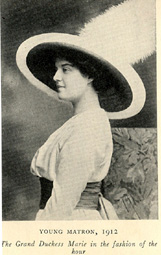
Russian Grand Duchess Marie in the latest elegant French dress in 1912 |
This natural influence of France, which in my opinion is related to her extraordinary vocation as eldest daughter of the Catholic Church, was taken advantage of by the revolutionary forces, who made Paris and France the seedbed for bad ideas, revolutionary art and extravagant fashions, and from there spread them throughout the world.
Certainly the French people had the gift of elegance. All the noble classes of the Western countries had elegance, but in France elegance was not a privilege only of the highest classes. It permeated the society from top to the bottom.
This gift in many senses began to fade after World War I, as egalitarian and libertarian trends started to accelerate in women’s clothing. They became increasingly vulgar, extravagant and immoral.In the ‘20s, high fashion promoted manly garb for women, shortening the skirt to the knees. The next decade saw advances toward nudity, especially in summer and beach clothing.
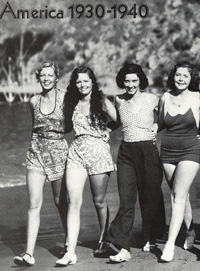
Between the wars summer clothing prepared for today's immorality
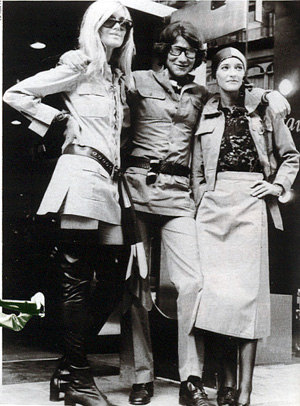
Yves Saint Laurent, center, in a pioneer unisex suit, poses with his models in the '60s |
After these initial changes came the great invasion of extravagance after World War II, there was a third decisive movement that revolutionized clothing: the Revolution of the Sorbonne in May 1968, or the Revolution of the '60s as it is better known here. One of the more characteristic fashions from that era was the mini-skirt. The famous French designer Courreges took the London mini-skirt, which was being flaunted in the lower ambiences there, and projected it onto the world fashion scene.
Besides the obvious immorality of the mini-skirt, a veritable revolution in feminine clothing took place. The luxurious accessories and elegant lines were gone. The elevated and aristocratic tone was abandoned, replaced by increasingly base and vulgar clothing. From Paris came a "unisex" fashion, and while unisex designs included shirts, trousers, shoes, jackets, etc., the most popular item was the blue jeans. At the beginning of the blue jean craze, the wearers went to great pains to fade and shrink them, until they began to appear ready-faded and frayed in the stores.
In 1968, the couturier Saint Laurent exclaimed: “À bas le Ritz! Vive la rue!” [Down with the Ritz! Long live the street!]. That is to say, down with distinction and ceremony. Out with good taste and delicacy! Long live vulgarity and sensuality!] This hippie revolution of 1968 changed the French haut couture. A dividing line can be drawn before and after the Sorbonne Revolution.
But even in the times when French haut couture was indisputably elegant, I don’t think that all the social elites should have followed it. This habit to follow a single style or just a few styles conflicts with an authentic liberty of costumes so characteristic of societies that are truly Catholic, that is: sacral, anti-liberal and anti-egalitarian.
Each people have their own vocation before God and their own traditions, which generate regional as well as national distinctions and charm in the dress of a people. When the elites were faithful representative of their countries’ past, they escaped this artificial production of styles that came from an outside influence. The more stable the institutions, customs and thinking of a people are, the more stable and less prone to constant and supercilious change will be its fashions.
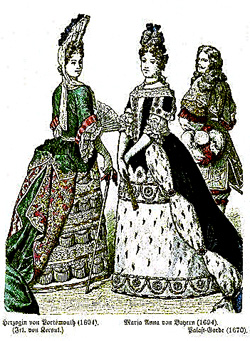
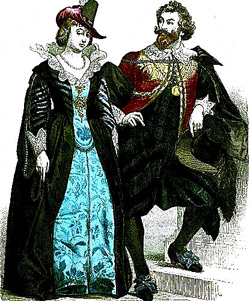
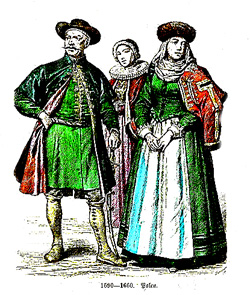
From top to bottom, 1800s fashions in Bavaria, Holland, and Poland. Each reflects a national character. |
We have an example of this with the peasants of many European countries, who kept their traditional dress, passed on from generation to generation. Each people developed a dress to represent its distinctive character. The folk dress of a Swedish girl was different from that of the Greek, and quite different from the traditional dress of a Japanese young woman. In my opinion, all of these dresses represent in a healthy way the characters of these peoples. They reflect their dignity and contain the seed of authentic elegance. Even when one can find some pagan influence here, or some rustic gauche note there, under the wise guidance of Catholic Civilization I am sure that these traditions would engender diverse patterns of authentic elegance.
This rule should apply as well to the higher classes. They also should represent their own traditions, and not allow themselves to become the slaves of fashion dictators.
I can give an example of how this kind of distinction and elegance was realized by the Hungarian gentry of the 18th and 19th centuries. To do this, let me shift the lens a little and move to men's clothing. The Hungarian elite refused to follow the French or English fashions that were already being imposed everywhere. The Magyar noblemen of that time knew how to develop the good traditions of their people and elaborated a distinctive style.
This can be seen in the quite refined military costume that they wore, which followed a Western pattern, but retained a characteristic loose cape, called the pelisse, made of black panther or leopard skins and hung from the left shoulder, and a distinctive brown fur bearskin hat, the busby. On the top of his hat was an aigrette, an ensemble of feathers fastened at the base with a splendid brooch of precious stone.
With this, the Hungarian noble managed to harmonically synthesize his barbaric origins with his Catholic history, the splendor and imagination of the East, represented by the cloak and hat, with the balance and proportion of the West, expressed in the double-breasted uniform. The result was a wonderful manifestation of the Hungarian personality. If someone would have insisted that those Hungarian nobles had to adopt the French or English style of dress, he would have destroyed a part of their personality.
This typical attire of the Hungarian nobles, in fact, inspired the uniform of the regiment of Hungarian Hussars, which adapted the costumes of the nobles. Therefore, the elite of Hungary did not feel the need to imitate any other country.
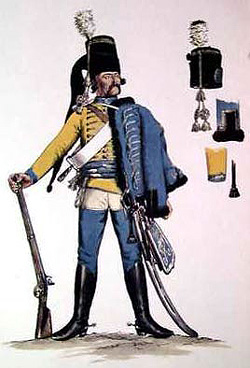 
At left, a Prussian Hussar and, at right, a French Hussar on horseback copy of the Hungarian costume
|
On the contrary, the nobles as well as officers and soldiers were so secure in wearing the costumes that followed their own traditions that it was others who copied them. The name, character and dress of the Hussars gradually spread into the Prussian, French, Austrian and British armies, each of which created their own Hussar Regiments.
Let me return to the ladies. In my opinion, to impose a single style on all the ladies dictating that all must dress according to the French rules and the men follow the English style is an erroneous simplification. It destroys the healthy diversity God established among peoples. It is the way to impose a kind of communism in the elites, instead of a communism in the proletariats.
4. Question – Can you explain what you mean by the term extravagance?
Answer – Let me make a brief reply. Perhaps we could return to this topic in another series of questions, because extravagance played an important role in the launching and acceptance of a new revolutionary fashion. Extravagant is an English word that comes from the Medieval Latin extra vagans which means “one who walks outside the normal road.” Applied to our case the word covers a large field.
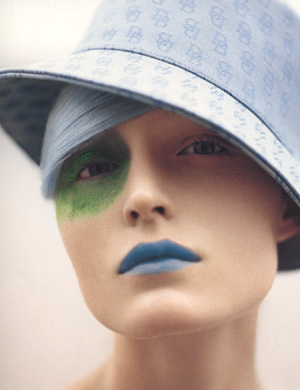
Extravagance in make-up |
It can signify wearing clothing just a little different from the normally accepted styles, such as someone who would wear blue or green fingernail polish instead of the usual red and pink. The other pole of extravagance extends all the way to using clothes or accessories that are absolutely shocking to good sense. Here, one finds the new fad of body-piercing – putting earrings in the nose, tongue, eyebrow, stomach etc – for both women and men. This is an extravagance with a hint of masochism.
In the picture you can see a model from a recent fashion advertisement who is wearing an extravagent make-up - an example that falls between the two limits but certainly tends toward the more radical punk.
5. Question – You mentioned the immorality of the fashions. What do you think is the correct Catholic position regarding so many fashions that have “evolved” with the times? You have bathing suits that were condemned yesterday as immoral and accepted today; you have the trousers that used to be forbidden for women and today are approved; you have the miniskirt and sleeveless tops that were considered immoral and today they are often worn to Mass and even to receive Communion. What are the moral principles that govern fashion?
Answer – To respond to this, I have to describe an incorrect current of ethics that approves and supports these things you mentioned.
Situational Morals, or Situation Ethics, is a progressivist interpretation of Catholic Morals that rests on the assumption that the norms that regulate private and social behavior should change with the times to accommodate the new mentalities and needs of men. Each norm can and should be adapted to each new situation. Hence its name: Situation Ethics.
This current is categorically wrong because it is relativist, that is, it considers that everything, including Morals, evolve with the times. It was strongly condemned by Pius XII as Modernist [1].
[1] Decree of the Congregation of the Holy Office in 1956, Acta Apostolicae Sedis 48, 1956, 114-145; Allocution to the World Federation of Young Women, January 18, 1952; Radio message on the Christian conscience, March 23, 1952; Allocution to the 5th International Congress of Psychotherapy and Psychology, November 13, 1953).
Today this condemnation has been forgotten since these very errors have been adopted in practice in innumerable subjects and applied almost everywhere in the “new” Morals of the Conciliar Church. This relativistic notion of Morals is influencing almost all the Catholic religious authorities and institutions. For this reason, we have the changes you described.
I am a fervent adept of the perennial Catholic Morals and I think that the same principles of decency and modesty regarding clothing that were applied yesterday should be accepted and applied today.
6. Question – What are these principles?
Answer – The Catholic Church always taught us that the way of dressing should meet three conditions: the needs of hygiene, modesty and decorum. Many Catholics are still aware of the first two standards, but have lost the sense of what satisfies the laws of proper decorum. The word decorum, which comes from dignity, means a way of being and manner appropriate to the dignity of your condition as a child of God, and appropriate to the respect you owe your neighbor who lives in society with you.
These three conditions, then, serve for the proper and upright development of a man’s physical, spiritual and social nature. If you need an authoritative source to support what I am saying, there is a valuable allocution that Pius XII gave on fashion (November 8, 1957).
7. Question – Could you describe these three conditions?
Answer – The first condition, hygiene, relates to the use of proper clothing to prevent sickness or harm to health. Let me mention here a common misunderstanding in this field. Countless people think that frequent exposure of the body to the sun will make them healthier and more attractive. But it had been proven that this exposure often causes skin cancer, thus destroying this myth of health. And that coveted "tan" will make the skin become leathery and hard as it ages, thus exploding this myth of beauty.
I know a woman who was always out “working on her tan.” When she learned that she had skin cancer because of long exposure to the sun, she panicked, and had to go through surgeries and long and painful treatments to return to a normal situation. Obviously, she lost her first enthusiasm on the subject of tans and began to cover herself.
You can see that good health is not antonymous with decency, and that the popular myth of having to wear no clothing in the heat is not so intelligent. A lesson could be learned from the Bedouin in the African desert, who has lived constantly under the sun since the time of Abraham. He covers himself almost completely in loose robes to protect himself from the sun.
8. Question – And what about the second condition, modesty?

A wedding dress should not be sleeveless or decollete, because it is a symbol of the purity of the bride. Above, the marriage of two German nobles, February 2001. Her dress demonstrates that fashion and morals can blend harmoniously today. |
Answer – The second condition, modesty, a word that comes from modus, a measure or limit, does in fact establish certain norms and limits in clothing to protect both the moral integrity of a person and to keep her from arousing sensual desires in others. As Pope Pius XII wisely said, “Modesty is the natural bulwark of chastity … because it moderates acts closely connected with the very object of chastity.”
The natural reason for modesty you can find in a wise explanation. The parts of the body that were given to mankind by God for the preservation of the species should be reserved for the prudent discretion, intimacy and privacy of the matrimonial life. They do not have any public function and, therefore, should not be displayed in public. It is not just full nudity or a blatant show of flesh that is prohibited. Modesty also prohibits the kind of clothing that insinuates what should not be shown. This applies mainly to feminine dress.
The supernatural reason for modest behavior is obedience to the Commandments of God and to preserve the virtue of chastity either outside or inside matrimony.
Developing the subject a bit further, the Church teaches us that there are three degrees of decency regarding the parts of the human body. Some parts are considered honest for show in public, some less honest, and other dishonest. Some moralists used to employ a more rigorous language, qualifying these parts as not-shameful, semi-shameful and shameful. The honest or not-shameful parts are the face, hands and feet; the less honest or semi-shameful are the lower neck, back, legs and arms; the dishonest or shameless are the reproductive organs and their proximities. The criterion that establishes this classification is the degree of incentive toward the sensual passions that the mentioned parts arouse.
Modesty is the most important of the conditions that govern fashion. No need of hygiene or elegance can surpass or prevail over the demands of modesty. That is, all dress must follow Catholic Morals with no exceptions to the rule.
9. Question – What about the last condition?
Answer – The third condition, decorum, is also important and quite neglected today. First, one has to consider the decorum each one should have with regard to himself, and then the decorum seemly and necessary in society.
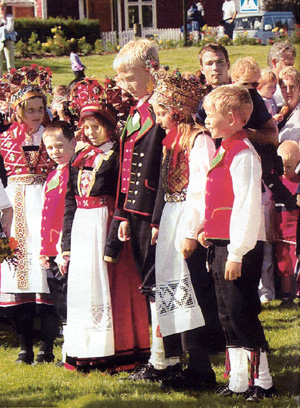
Traditional peasant dress - simple, decorous, colorful - and timeless in its charm |
Since each one of us is made to the image and likeness of God, each one of us has an importance and dignity that derives from this. Each man and woman is deserving of respect. This begins with self-respect. Each one should take himself seriously. The consequence of this self-respect regarding decorum is that each one should present himself in a dignified way. What does this mean?
The first requirement is, of course, cleanliness of person and dress; the second is seemliness and propriety in manners and clothing. There is a wise motto, very Catholic in spirit, that says “To be clean is the luxury of the poor.” No one who respects himself, be he poor or rich, should be remiss in cleanliness. It does not take wealth to apply the binomial water and soap that meets perfectly in a reality called the shower, which produces that indispensable point of decorum, which is to be dirt free. Likewise, clothing – be it rich or poor – should be clean.
After this, comes self-presentation. I am not talking about fashion yet, but rather its presupposition. After cleanliness comes propriety: hair combed, shirt buttoned, coat brushed, shoes polished, nails buffed. I know these are very simple things, but if you look around you, you will see that even these elementary rules of decorum are not being taught or practiced today.
There is also a false notion that decorum only needs to be observed if you are “going out” or will be seen by others. Even if you are staying at home without receiving anyone, be correctly dressed. This is the respect you owe yourself to feel dignified. In fact you are not only an image of God, but you are always in His presence, and in the presence of His Angels and Saints, and should present yourself taking this in consideration. This is the decorum each one owes to himself as a child of God.
There is a second part, which is the decorum one should have in society. Your neighbor is also a creature of God and deserves respect. This is why one practices decorum in manners and conduct toward others. The practice of courtesy in daily life is an art that the French people call savoir plaire, to know how to please in order to make the life of your neighbor more agreeable. It is a social reflection of the virtue of charity. If everyone showed the concern to be more amiable and kind to his neighbor, our lives in society would be much more pleasant and bearable. In this art of pleasing others one could include the moderate attempt for women to adorn themselves and accentuate some points of their beauty.
Women have a natural inclination to accentuate their elegance and beauty in order to please: to please the company around them in general, but also it is the natural inclination of women who want to attract a husband if they are single, or to please their husbands if they are married. Therefore, this desire to dress nicely and make oneself pleasing to other derives from nature and is quite legitimate. You don’t need to spend great amounts of money or have the latest fashion be to be pleasing in your dress.
What is wrong is the tendency to use feminine dress to seduce. This is condemnable. The Church always taught us that the decorum must rely on modesty.
10. Question – How would you apply these rules of decorum to women as they become older and lose some of their natural elements of beauty?
Answer – Let me first address a basic principle and then apply it to the question. The Catholic position rejects the notion that a lady should try to feign a beauty that she does not have. Truth is always a characteristic of the Catholic. What a Catholic lady, regardless of her physical beauty, always has is her innate dignity. Whatever her age or station of life, she should not try to fool others by pretending to have what she does not.
This applies in particular to ladies of more mature age. They do not need to pretend to a beauty that has waned or passed. What they should have is something more precious, a beauty of soul that has matured following the precepts of the Catholic Morals. This is what pleases and causes respect. How dignified the elderly of past decades were! How much respect and confidence they inspired! The aura of dignity, seriousness and serene happiness reflected not only in their countenance and bearing, but in a decorous clothing that reflected their maturity.
Unfortunately, nowadays this attempt to appear what one is not also applies to men. Today we can find mature or even quite old men who try to appear younger at all costs. Here one appears in public in jogging apparel, another has dyed hair, yet another is dressed in bermudas and T-shirts like a teenager. In times past it was the opposite. The youth, in his ardent desire for responsibility, maturity and action, aspired to dress like a man - serious and solemn. The revolutionary idea that a man should no longer be serious is producing this ridiculous generation of "boys" - whatever be the age. In my opinion, instead of prolonging their youth they are advancing all the faster to senility, since it is difficult to take such a person seriously.
St. Frances de Sales had a succinct word to say on ladies and gentlemen rich in age: “Old people are always ridiculous when they try to appear young.” “Instead,” he advises, “let them adorn themselves with gracefulness, decency and dignity.” It is a wise counsel that applies well to all times, not excepting our own.
*
I have given the bare outlines of some of the psychological and moral factors that should apply to fashion. Obviously, each point could be further developed with examples and quotes. But here I only wanted to lay out some basic principles of Catholic fashion, which I am taking from Pius XII and some other good moralists.
Catholic fashion is a reality. It is something very worth developing and working for, and it lies within the natural feminine realm where women can exercise their delicacy and good taste.
|
Manners | Cultural | Home | Books | CDs | Search | Contact Us | Donate

© 2002- Tradition in Action, Inc. All Rights Reserved
|
 |
|